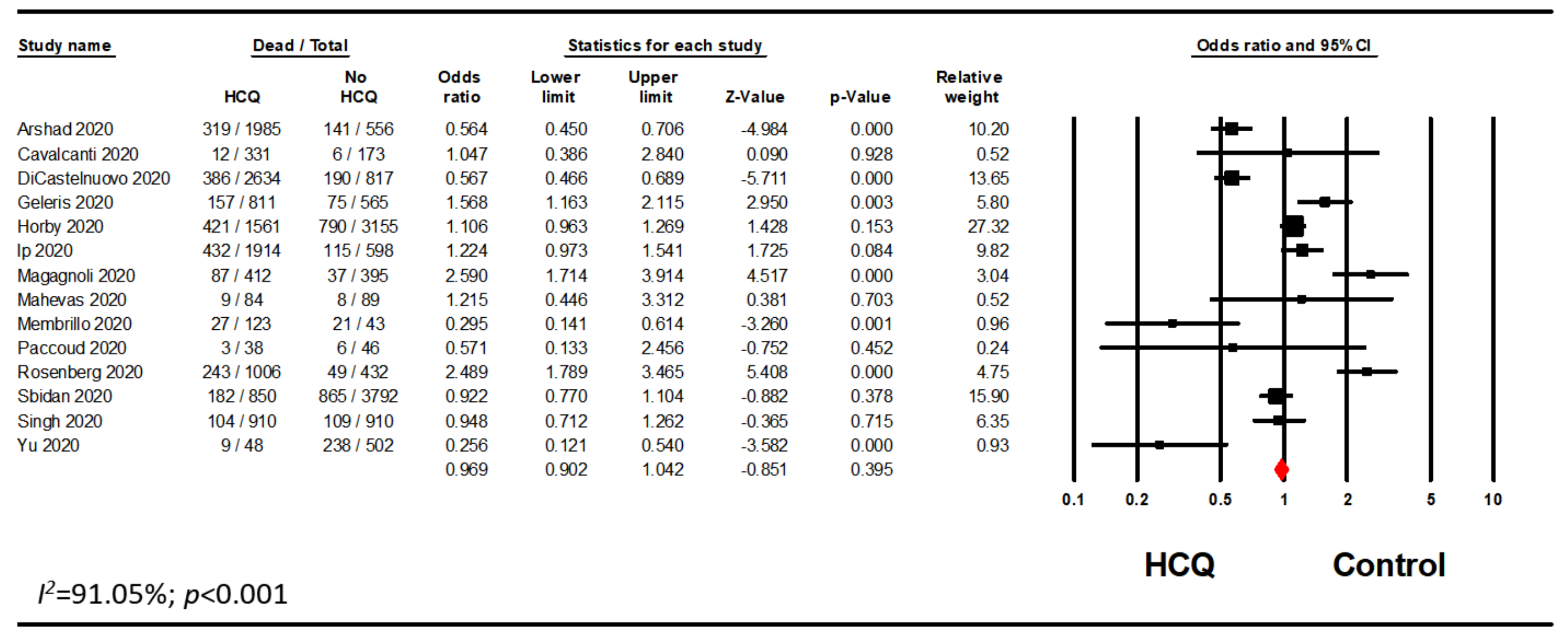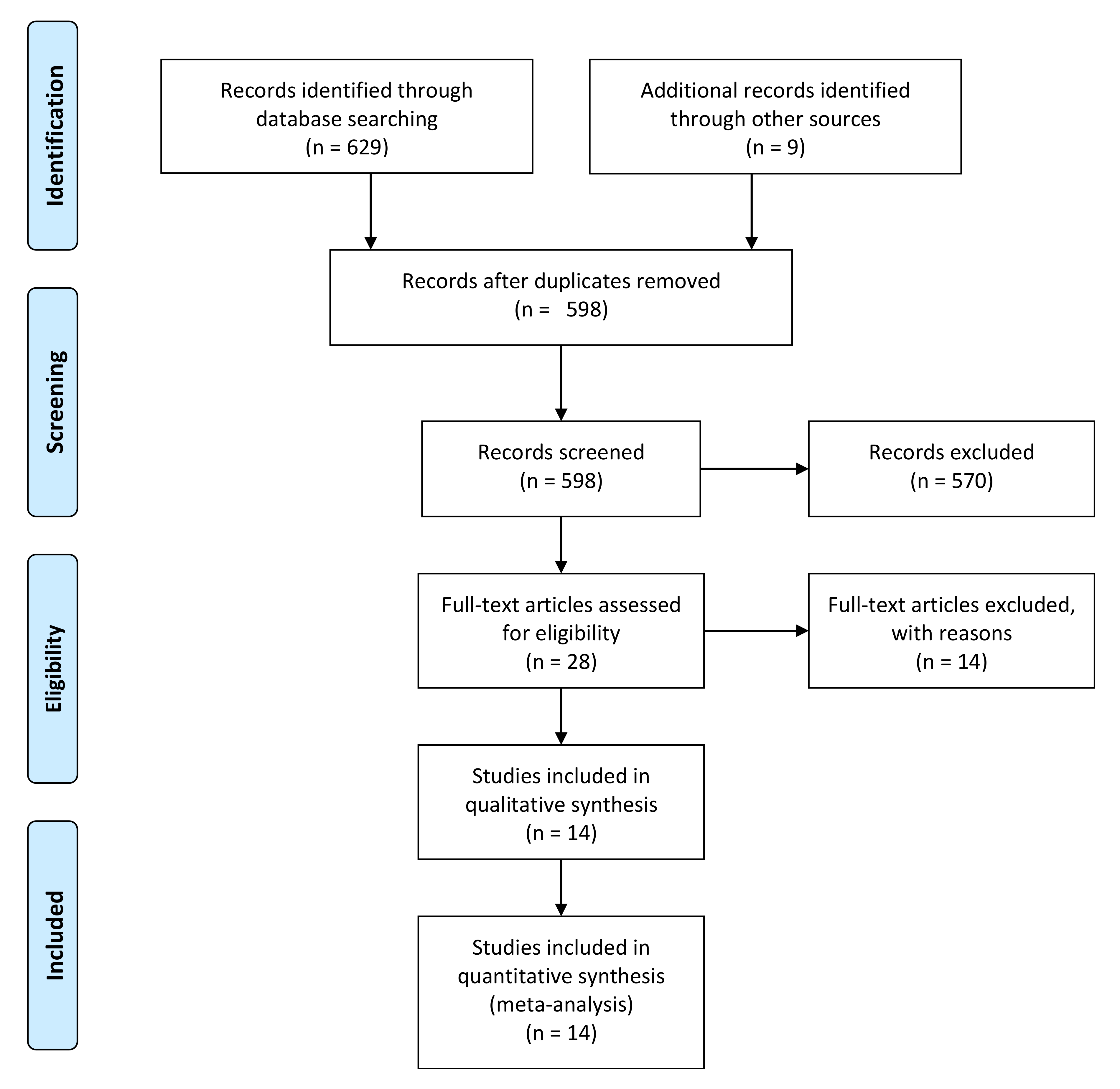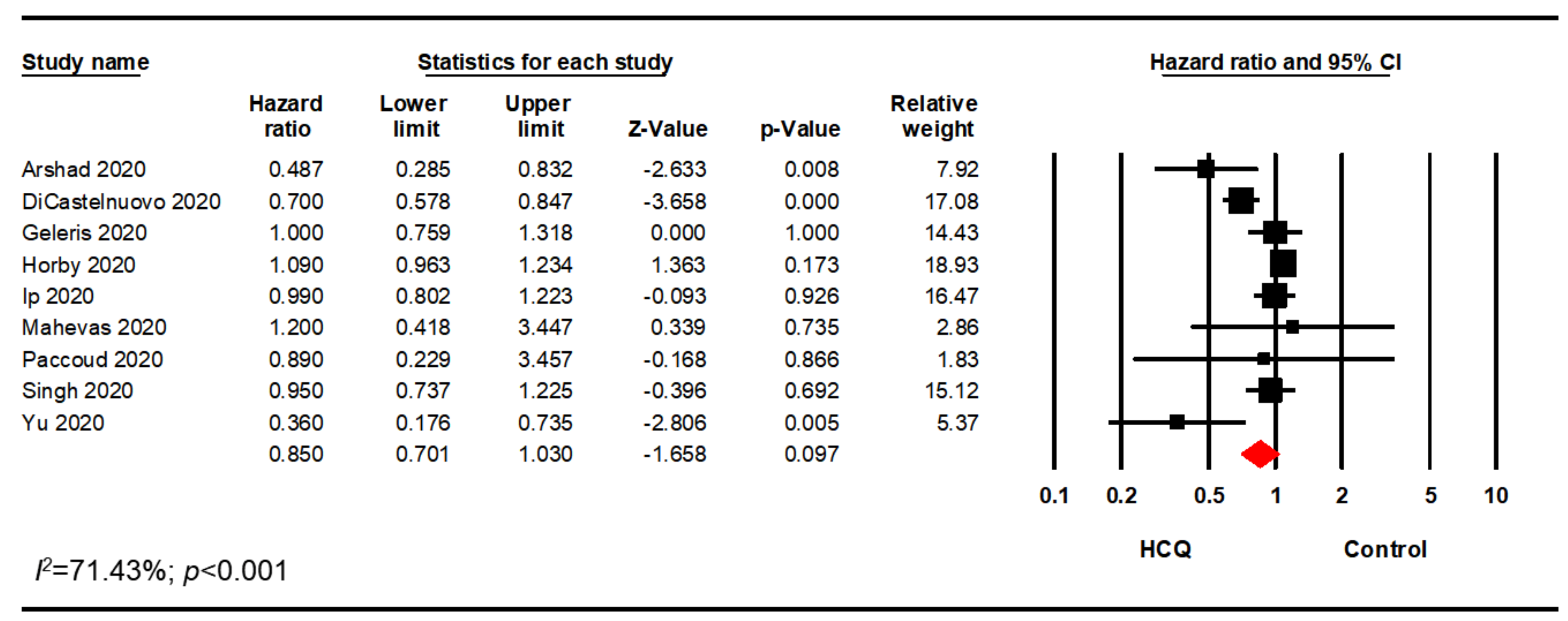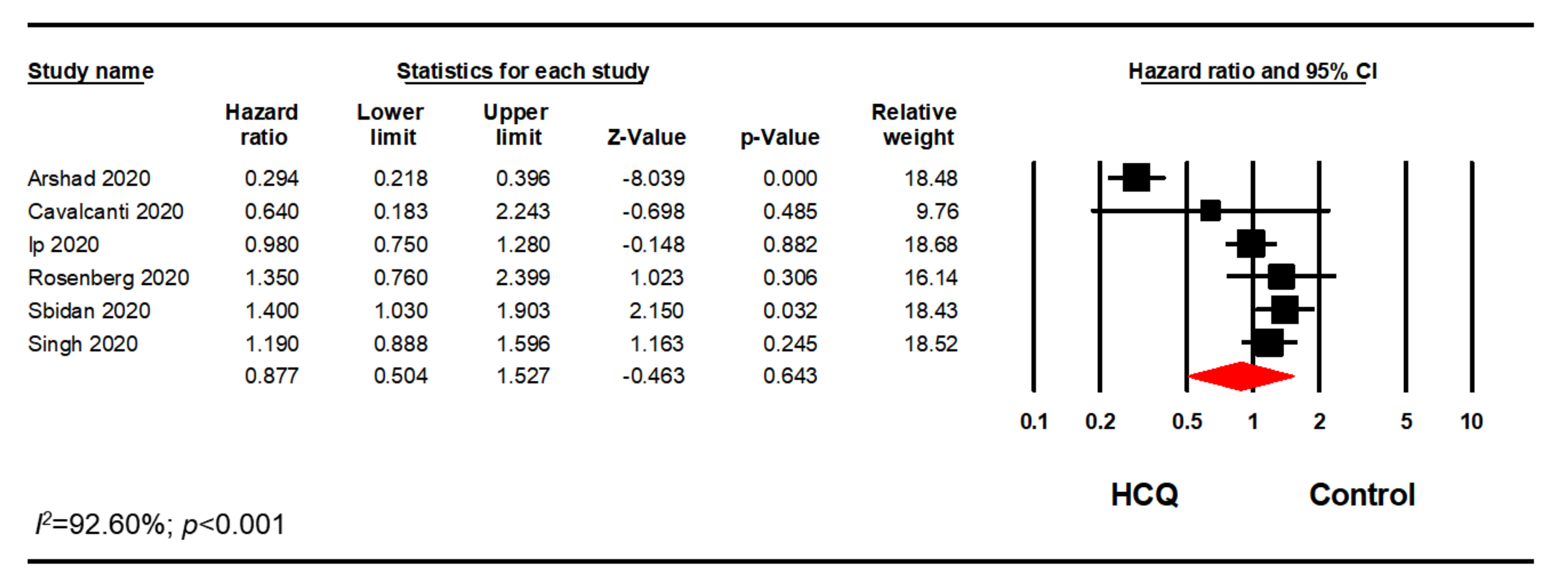Impact of Hydroxychloroquine on Mortality in Hospitalized Patients with COVID-19: Systematic Review and Meta-Analysis
Abstract
1. Introduction
2. Materials and Methods
2.1. Search Strategy and Study Selection
2.2. Inclusion and Exclusion Criteria
2.3. Data Extraction and Study Quality
2.4. Outcomes Assessed
2.5. Statistical Analyses
3. Results
3.1. Mortality with Any HCQ Exposure
3.2. Mortality with HCQ Alone
3.3. Mortality with HCQ in Combination with AZI
4. Discussion
5. Conclusions
Author Contributions
Funding
Acknowledgments
Conflicts of Interest
Appendix A


| Domain | Arshad 2020 | Di Castelnuovo 2020 | Geleris 2020 | Ip 2020 | Magagnoli 2020 | Mahevas 2020 | Membrillo 2020 | Paccoud 2020 | Rosenberg 2020 | Sibidan 2020 | Singh 2020 | Yu 2020 | |
|---|---|---|---|---|---|---|---|---|---|---|---|---|---|
| Selection | Representativeness/Case Definition | 1 | 1 | 1 | 1 | 1 | 1 | 1 | 1 | 1 | 1 | 1 | 1 |
| Selection of non-exposed/cases | 1 | 1 | 1 | 1 | 1 | 1 | 1 | 1 | 1 | 1 | 1 | 1 | |
| Ascertainment of exposure/selection of controls | 1 | 1 | 1 | 1 | 1 | 1 | 1 | 1 | 1 | 1 | 1 | 1 | |
| Baseline assessment/definition of controls | 1 | 1 | 1 | 1 | 1 | 1 | 1 | 1 | 1 | 1 | 1 | 1 | |
| Comparability | Confounders identified | 1 | 1 | 1 | 1 | 1 | 1 | 0 | 1 | 1 | 1 | 1 | 1 |
| Statistical adjustment | 1 | 1 | 1 | 1 | 1 | 1 | 0 | 1 | 1 | 1 | 1 | 1 | |
| Outcome/exposure | Outcome/exposure assessment | 1 | 1 | 1 | 1 | 1 | 1 | 1 | 1 | 1 | 1 | 1 | 0 |
| Follow-up/method for ascertainment of 1exposure | 1 | 1 | 1 | 1 | 1 | 0 | 1 | 1 | 1 | 1 | 1 | 1 | |
| A1dequacy of follow-up/non-response rate | 1 | 1 | 1 | 1 | 1 | 1 | 1 | 1 | 1 | 1 | 1 | 1 | |
| Total Score | 7 | 9 | 9 | 9 | 9 | 8 | 7 | 9 | 9 | 9 | 9 | 8 |
| Domain | Cavalcanti 2020 | Horby 2020 |
|---|---|---|
| Randomization | 2 | 2 |
| Blinding | 0 | 0 |
| Withdrawals | 1 | 1 |
| Total Score | 3 | 3 |

| Section/Topic | # | Checklist Item | Reported on Page # |
|---|---|---|---|
| Title | |||
| Title | 1 | Identify the report as a systematic review, meta-analysis, or both. | 1 |
| Abstract | |||
| Structured summary | 2 | Provide a structured summary including, as applicable: background; objectives; data sources; study eligibility criteria, participants, and interventions; study appraisal and synthesis methods; results; limitations; conclusions and implications of key findings; systematic review registration number. | 1 |
| Introduction | |||
| Rationale | 3 | Describe the rationale for the review in the context of what is already known. | 1–2 |
| Objectives | 4 | Provide an explicit statement of questions being addressed with reference to participants, interventions, comparisons, outcomes, and study design (PICOS). | 2 |
| Methods | |||
| Protocol and registration | 5 | Indicate if a review protocol exists, if and where it can be accessed (e.g., Web address), and, if available, provide registration information including registration number. | Available upon request |
| Eligibility criteria | 6 | Specify study characteristics (e.g., PICOS, length of follow-up) and report characteristics (e.g., years considered, language, publication status) used as criteria for eligibility, giving rationale. | 2–3 |
| Information sources | 7 | Describe all information sources (e.g., databases with dates of coverage, contact with study authors to identify additional studies) in the search and date last searched. | 2 |
| Search | 8 | Present full electronic search strategy for at least one database, including any limits used, such that it could be repeated. | 2, Table A4 |
| Study selection | 9 | State the process for selecting studies (i.e., screening, eligibility, included in systematic review, and, if applicable, included in the meta-analysis). | 2–3 |
| Data collection process | 10 | Describe method of data extraction from reports (e.g., piloted forms, independently, in duplicate) and any processes for obtaining and confirming data from investigators. | 3 |
| Data items | 11 | List and define all variables for which data were sought (e.g., PICOS, funding sources) and any assumptions and simplifications made. | 3 |
| Risk of bias in individual studies | 12 | Describe methods used for assessing risk of bias of individual studies (including specification of whether this was done at the study or outcome level), and how this information is to be used in any data synthesis. | 4 |
| Summary measures | 13 | State the principal summary measures (e.g., risk ratio, difference in means). | 4 |
| Synthesis of results | 14 | Describe the methods of handling data and combining results of studies, if done, including measures of consistency (e.g., I2) for each meta-analysis. | 4 |
| Risk of bias across studies | 15 | Specify any assessment of risk of bias that may affect the cumulative evidence (e.g., publication bias, selective reporting within studies). | 4 |
| Additional analyses | 16 | Describe methods of additional analyses (e.g., sensitivity or subgroup analyses, meta-regression), if done, indicating which were pre-specified. | 4 |
| Results | |||
| Study selection | 17 | Give numbers of studies screened, assessed for eligibility, and included in the review, with reasons for exclusions at each stage, ideally with a flow diagram. | 4–5, Figure A3 |
| Study characteristics | 18 | For each study, present characteristics for which data were extracted (e.g., study size, PICOS, follow-up period) and provide the citations. | 4–5, Table 1 |
| Risk of bias within studies | 19 | Present data on risk of bias of each study and, if available, any outcome level assessment (see item 12). | 5, Figure 2 |
| Results of individual studies | 20 | For all outcomes considered (benefits or harms), present, for each study: (a) simple summary data for each intervention group (b) effect estimates and confidence intervals, ideally with a forest plot. | 5–7, Figure 1 and Figure 3 |
| Synthesis of results | 21 | Present results of each meta-analysis done, including confidence intervals and measures of consistency. | 5–7, Figure 1 and Figure 3 |
| Risk of bias across studies | 22 | Present results of any assessment of risk of bias across studies (see Item 15). | 5, Figure 2 |
| Additional analysis | 23 | Give results of additional analyses, if done (e.g., sensitivity or subgroup analyses, meta-regression [see Item 16]). | Figure 4, Figure 5, Figure 6, Figure 7, Figure A1 and Figure A2 |
| Discussion | |||
| Summary of evidence | 24 | Summarize the main findings including the strength of evidence for each main outcome; consider their relevance to key groups (e.g., healthcare providers, users, and policy makers). | 8–9 |
| Limitations | 25 | Discuss limitations at study and outcome level (e.g., risk of bias), and at review-level (e.g., incomplete retrieval of identified research, reporting bias). | 8 |
| Conclusions | 26 | Provide a general interpretation of the results in the context of other evidence, and implications for future research. | 8–9 |
| Funding | |||
| Funding | 27 | Describe sources of funding for the systematic review and other support (e.g., supply of data); role of funders for the systematic review. | 9 |
Appendix B
| PubMed | https://pubmed.ncbi.nlm.nih.gov/?term=%28%28Hydroxychloroquine%29+AND+%28COVID-19+or+SARS-CoV-2+or+Coronavirus%29%29+AND+%28Mortality%29&sort=date&filter=datesearch.y_1&filter=hum_ani.humans (Hydroxychloroquine) AND (COVID-19 OR SARS-CoV-2 OR Coronavirus) AND (Mortality) |
| MedRxiv | https://www.medrxiv.org/search/Hydroxychloroquine%252BCOVID-19%252BMortality%252B Hydroxychloroquine COVID-19 Mortality |
References
- Worldometer. COVID-19 Coronavirus Pandemic. Available online: https://www.worldometers.info/coronavirus/ (accessed on 4 November 2020).
- Beigel, J.H.; Tomashek, K.M.; Dodd, L.E.; Mehta, A.K.; Zingman, B.S.; Kalil, A.C.; Hohmann, E.; Chu, H.Y.; Luetkemeyer, A.; Kline, S.; et al. Remdesivir for the treatment of Covid-19—final report. N. Engl. J. Med. 2020. [Google Scholar] [CrossRef] [PubMed]
- National Institutes of Health. COVID-19 Treatment Guidelines. Available online: https://files.covid19treatmentguidelines.nih.gov/guidelines/covid19treatmentguidelines.pdf (accessed on 4 November 2020).
- Wu, R.; Wang, L.; Kuo, H.D.; Shannar, A.; Peter, R.; Chou, P.J.; Li, S.; Hudlikar, R.; Liu, X.; Liu, Z.; et al. An Update on current therapeutic drugs treating COVID-19. Curr. Pharmacol. Rep. 2020, 1–15. [Google Scholar] [CrossRef]
- Gautret, P.; Lagier, J.C.; Parola, P.; Hoang, V.T.; Meddeb, L.; Mailhe, M.; Doudier, B.; Courjon, J.; Giordanengo, V.; Vieira, V.E.; et al. Hydroxychloroquine and azithromycin as a treatment of COVID-19: Results of an open-label non-randomized clinical trial. Int. J. Antimicrob. Agents 2020, 56, 105949. [Google Scholar] [CrossRef] [PubMed]
- Gautret, P.; Lagier, J.C.; Parola, P.; Hoang, V.T.; Meddeb, L.; Sevestre, J.; Mailhe, M.; Doudier, B.; Aubry, C.; Amrane, S.; et al. Clinical and microbiological effect of a combination of hydroxychloroquine and azithromycin in 80 COVID-19 patients with at least a six-day follow up: A pilot observational study. Travel Med. Infect. Dis. 2020, 34, 101663. [Google Scholar] [CrossRef]
- Yao, X.; Ye, F.; Zhang, M.; Cui, C.; Huang, B.; Niu, P.; Liu, X.; Zhao, L.; Dong, E.; Song, C.; et al. In Vitro antiviral activity and projection of optimized dosing design of hydroxychloroquine for the treatment of Severe Acute Respiratory Syndrome Coronavirus 2 (SARS-CoV-2). Clin. Infect. Dis. 2020, 71, 732–739. [Google Scholar] [CrossRef]
- Voss, A.; Coombs, G.; Unal, S.; Saginur, R.; Hsueh, P.R. Publishing in face of the COVID-19 pandemic. Int. J. Antimicrob. Agents 2020, 56, 106081. [Google Scholar] [CrossRef] [PubMed]
- Vincent, M.J.; Bergeron, E.; Benjannet, S.; Erickson, B.R.; Rollin, P.E.; Ksiazek, T.G.; Seidah, N.G.; Nichol, S.T. Chloroquine is a potent inhibitor of SARS coronavirus infection and spread. Virol. J. 2005, 2, 69. [Google Scholar] [CrossRef]
- Simmons, G.; Reeves, J.D.; Rennekamp, A.J.; Amberg, S.M.; Piefer, A.J.; Bates, P. Characterization of severe acute respiratory syndrome-associated coronavirus (SARS-CoV) spike glycoprotein-mediated viral entry. Proc. Natl. Acad. Sci. USA 2004, 101, 4240–4245. [Google Scholar] [CrossRef]
- FDA Drug Safety Warning. Available online: https://www.fda.gov/drugs/drug-safety-and-availability/fda-cautions-against-use-hydroxychloroquine-or-chloroquine-covid-19-outside-hospital-setting-or (accessed on 16 September 2020).
- Fiolet, T.; Guihur, A.; Rebeaud, M.; Mulot, M.; Peiffer-Smadja, N.; Mahamat-Saleh, Y. Effect of hydroxychloroquine with or without azithromycin on the mortality of COVID-19 patients: A systematic review and meta-analysis. Clin. Microbiol. Infect. 2020. [Google Scholar] [CrossRef]
- Patel, T.K.; Barvaliya, M.; Kevadiya, B.D.; Patel, P.B.; Bhalla, H.L. Does adding of hydroxychloroquine to the standard care provide any benefit in reducing the mortality among COVID-19 patients?: A systematic review. J. Neuroimmune Pharmacol. 2020, 15, 350–358. [Google Scholar] [CrossRef]
- Sarma, P.; Kaur, H.; Kumar, H.; Mahendru, D.; Avti, P.; Bhattacharyya, A.; Prajapat, M.; Shekhar, N.; Kumar, S.; Singh, R.; et al. Virological and clinical cure in COVID-19 patients treated with hydroxychloroquine: A systematic review and meta-analysis. J. Med. Virol. 2020, 92, 776–785. [Google Scholar] [CrossRef]
- Singh, S.; Khan, A.; Chowdhry, M.; Chatterjee, A. Outcomes of hydroxychloroquine treatment among hospitalized COVID-19 patients in the United States- Real-world evidence from a federated electronic medical record network. medRxiv 2020. [Google Scholar] [CrossRef]
- Moher, D.; Liberati, A.; Tetzlaff, J.; Altman, D.G.; Group, P. Preferred reporting items for systematic reviews and meta-analyses: The PRISMA statement. Ann. Intern. Med. 2009, 151, 264–269. [Google Scholar] [CrossRef] [PubMed]
- Wells, G.A.; Shea, B.; O’Connell, D.; Peterson, J.; Welch, V.; Losos, M.; Tugwell, P. The Newcastle-Ottawa Scale (NOS) for Assessing the Quality of Nonrandomised Studies in Meta-Analyses. Available online: http://www.ohri.ca/programs/clinical_epidemiology/oxford.asp (accessed on 10 September 2020).
- Jadad, A.R.; Moore, R.A.; Carroll, D.; Jenkinson, C.; Reynolds, D.J.; Gavaghan, D.J.; McQuay, H.J. Assessing the quality of reports of randomized clinical trials: Is blinding necessary? Control Clin. Trials 1996, 17, 1–12. [Google Scholar] [CrossRef]
- Tang, W.; Cao, Z.; Han, M.; Wang, Z.; Chen, J.; Sun, W.; Wu, Y.; Xiao, W.; Liu, S.; Chen, E.; et al. Hydroxychloroquine in patients with mainly mild to moderate coronavirus disease 2019: Open label, randomised controlled trial. BMJ 2020, 369, m1849. [Google Scholar] [CrossRef] [PubMed]
- Ramireddy, A.; Chugh, H.; Reinier, K.; Ebinger, J.; Park, E.; Thompson, M.; Cingolani, E.; Cheng, S.; Marban, E.; Albert, C.M.; et al. Experience with hydroxychloroquine and azithromycin in the Coronavirus Disease 2019 pandemic: Implications for QT interval monitoring. J. Am. Heart Assoc. 2020, 9, e017144. [Google Scholar] [CrossRef]
- Chen, Z.; Hu, J.; Zhang, Z.; Jiang, S.; Han, S.; Yan, D.; Zhuang, R.; Hu, B.; Zhang, Z. Efficacy of hydroxychloroquine in patients with COVID-19: Results of a randomized clinical trial. medRxiv 2020. [Google Scholar] [CrossRef]
- Chen, L.; Zhang, Z.-y.; Fu, J.-g.; Feng, Z.-p.; Zhang, S.-Z.; Han, Q.-Y.; Zhang, X.-b.; Xiao, X.; Chen, H.-M.; Liu, L.-L.; et al. Efficacy and safety of chloroquine or hydroxychloroquine in moderate type of COVID-19: A prospective open-label randomized controlled study. medRxiv 2020. [Google Scholar] [CrossRef]
- An, M.H.; Kim, M.S.; park, Y.; Kim, B.-O.; Kang, S.H.; Kimn, W.J.; Park, S.K.; Park, H.-W.; Yang, W.; Jang, J.; et al. Treatment Response to Hydroxychloroquine and antibiotics for mild to moderate COVID-19: A retrospective cohort study from South Korea. medRxiv 2020. [Google Scholar] [CrossRef]
- Kim, M.S.; Jang, S.-W.; Park, Y.-K.; Kim, B.-O.; Hwang, T.-H.; Kang, S.H.; Kim, W.J.; Park, H.-W.; Yang, W.; Jang, J.; et al. Treatment response to hydroxychloroquine, lopinavir/ritonavir, and antibiotics for moderate COVID 19: A first report on the pharmacological outcomes from South Korea. medRxiv 2020. [Google Scholar] [CrossRef]
- Million, M.; Lagier, J.C.; Gautret, P.; Colson, P.; Fournier, P.E.; Amrane, S.; Hocquart, M.; Mailhe, M.; Esteves-Vieira, V.; Doudier, B.; et al. Early treatment of COVID-19 patients with hydroxychloroquine and azithromycin: A retrospective analysis of 1061 cases in Marseille, France. Travel Med. Infect. Dis. 2020, 35, 101738. [Google Scholar] [CrossRef]
- Ahmad, I.; Alam, M.; Saadi, R.; Mahmud, S.; Saadi, E. Doxycycline and hydroxychloroquine as treatment for high-risk COVID-19 Patients: Experience from case series of 54 patients in long-term care facilities. medRxiv 2020. [Google Scholar] [CrossRef]
- Boulware, D.R.; Pullen, M.F.; Bangdiwala, A.S.; Pastick, K.A.; Lofgren, S.M.; Okafor, E.C.; Skipper, C.P.; Nascene, A.A.; Nicol, M.R.; Abassi, M.; et al. A randomized trial of hydroxychloroquine as postexposure prophylaxis for Covid-19. N. Engl. J. Med. 2020, 383, 517–525. [Google Scholar] [CrossRef]
- Lecronier, M.; Beurton, A.; Burrel, S.; Haudebourg, L.; Deleris, R.; Le Marec, J.; Virolle, S.; Nemlaghi, S.; Bureau, C.; Mora, P.; et al. Comparison of hydroxychloroquine, lopinavir/ritonavir, and standard of care in critically ill patients with SARS-CoV-2 pneumonia: An opportunistic retrospective analysis. Crit. Care 2020, 24, 418. [Google Scholar] [CrossRef] [PubMed]
- Trecarichi, E.M.; Mazzitelli, M.; Serapide, F.; Pelle, M.C.; Tassone, B.; Arrighi, E.; Perri, G.; Fusco, P.; Scaglione, V.; Davoli, C.; et al. Characteristics, outcome and predictors of in-hospital mortality in an elderly population from a SARS-CoV-2 outbreak in a long-term care facility. medRxiv 2020. [Google Scholar] [CrossRef]
- Karolyi, M.; Pawelka, E.; Mader, T.; Omid, S.; Kelani, H.; Ely, S.; Jilma, B.; Baumgartner, S.; Laferl, H.; Ott, C.; et al. Hydroxychloroquine versus lopinavir/ritonavir in severe COVID-19 patients: Results from a real-life patient cohort. Wien. Klin. Wochenschr. 2020. [Google Scholar] [CrossRef]
- Yu, B.; Li, C.; Chen, P.; Zhou, N.; Wang, L.; Li, J.; Jiang, H.; Wang, D.W. Low dose of hydroxychloroquine reduces fatality of critically ill patients with COVID-19. Sci. China Life Sci. 2020. [Google Scholar] [CrossRef] [PubMed]
- Sbidian, E.; Josse, J.; Lemaitre, G.; Mayer, I.; Bernaux, M.; Gramfort, A.; Lapidus, N.; Paris, N.; Neuraz, A.; Lerner, I.; et al. Hydroxychloroquine with or without azithromycin and in-hospital mortality or discharge in patients hospitalized for COVID-19 infection: A cohort study of 4,642 in-patients in France. medRxiv 2020. [Google Scholar] [CrossRef]
- Rosenberg, E.S.; Dufort, E.M.; Udo, T.; Wilberschied, L.A.; Kumar, J.; Tesoriero, J.; Weinberg, P.; Kirkwood, J.; Muse, A.; DeHovitz, J.; et al. Association of treatment with hydroxychloroquine or azithromycin with in-hospital mortality in patients with COVID-19 in New York State. JAMA 2020. [Google Scholar] [CrossRef]
- Mahevas, M.; Tran, V.T.; Roumier, M.; Chabrol, A.; Paule, R.; Guillaud, C.; Fois, E.; Lepeule, R.; Szwebel, T.A.; Lescure, F.X.; et al. Clinical efficacy of hydroxychloroquine in patients with covid-19 pneumonia who require oxygen: Observational comparative study using routine care data. BMJ 2020, 369, m1844. [Google Scholar] [CrossRef]
- Magagnoli, J.; Narendran, S.; Pereira, F.; Cummings, T.H.; Hardin, J.W.; Sutton, S.S.; Ambati, J. Outcomes of hydroxychloroquine usage in United States veterans hospitalized with COVID-19. Med (N.Y.) 2020. [Google Scholar] [CrossRef]
- Ip, A.; Berry, D.A.; Hansen, E.; Goy, A.H.; Pecora, A.L.; Sinclaire, B.A.; Bednarz, U.; Marafelias, M.; Berry, S.M.; Berry, N.S.; et al. Hydroxychloroquine and tocilizumab therapy in COVID-19 patients-An observational study. PLoS ONE 2020, 15, e0237693. [Google Scholar] [CrossRef] [PubMed]
- Geleris, J.; Sun, Y.; Platt, J.; Zucker, J.; Baldwin, M.; Hripcsak, G.; Labella, A.; Manson, D.K.; Kubin, C.; Barr, R.G.; et al. Observational study of hydroxychloroquine in hospitalized patients with Covid-19. N. Engl. J. Med. 2020, 382, 2411–2418. [Google Scholar] [CrossRef]
- Cavalcanti, A.B.; Zampieri, F.G.; Rosa, R.G.; Azevedo, L.C.P.; Veiga, V.C.; Avezum, A.; Damiani, L.P.; Marcadenti, A.; Kawano-Dourado, L.; Lisboa, T.; et al. Hydroxychloroquine with or without azithromycin in mild-to-moderate Covid-19. N. Engl. J. Med. 2020. [Google Scholar] [CrossRef]
- Castelnuovo, A.D.; Costanzo, S.; Antinori, A.; Berselli, N.; Blandi, L.; Bruno, R.; Cauda, R.; Guaraldi, G.; Menicanti, L.; My, I.; et al. Use of hydroxychloroquine in hospitalised COVID-19 patients is associated with reduced mortality: Findings from the observational multicentre Italian CORIST study. Eur. J. Intern. Med. 2020. [Google Scholar] [CrossRef]
- Arshad, S.; Kilgore, P.; Chaudhry, Z.S.; Jacobsen, G.; Wang, D.D.; Huitsing, K.; Brar, I.; Alangaden, G.J.; Ramesh, M.S.; McKinnon, J.E.; et al. Treatment with hydroxychloroquine, azithromycin, and combination in patients hospitalized with COVID-19. Int. J. Infect. Dis. 2020, 97, 396–403. [Google Scholar] [CrossRef] [PubMed]
- Membrillo de Novales, F.J.; Ramírez-Olivencia, G.; Estébanez, M.; de Dios, B.; Herrero, M.D.; Mata, T.; Borobia, A.M.; Gutiérrez, C.; Simón, M.; Ochoa, A.; et al. Early hydroxychloroquine is associated with an increase of survival in COVID-19 patients: An Observational Study. Preprints 2020. Available online: https://www.altmetric.com/details/81373229 (accessed on 16 September 2020). [CrossRef]
- Paccoud, O.; Tubach, F.; Baptiste, A.; Bleibtreu, A.; Hajage, D.; Monsel, G.; Tebano, G.; Boutolleau, D.; Klement, E.; Godefroy, N.; et al. Compassionate use of hydroxychloroquine in clinical practice for patients with mild to severe Covid-19 in a French university hospital. Clin. Infect. Dis. 2020. [Google Scholar] [CrossRef]
- Group, R.C.; Horby, P.; Mafham, M.; Linsell, L.; Bell, J.L.; Staplin, N.; Emberson, J.R.; Wiselka, M.; Ustianowski, A.; Elmahi, E.; et al. Effect of hydroxychloroquine in hospitalized patients with Covid-19. N. Engl. J. Med. 2020. [Google Scholar] [CrossRef]
- Peterson, A.; Largent, E.A.; Karlawish, J. Ethics of reallocating ventilators in the covid-19 pandemic. BMJ 2020, 369, m1828. [Google Scholar] [CrossRef]
- Drucker, D.J. Coronavirus infections and type 2 diabetes-shared pathways with therapeutic implications. Endocr. Rev. 2020, 41. [Google Scholar] [CrossRef] [PubMed]
- Kong, A.N.; Lau, A.T.Y.; Brunetti, L. Hot topic commentary on COVID-19. Curr. Pharmacol. Rep. 2020. [Google Scholar] [CrossRef] [PubMed]
- Ma, L.; Song, K.; Huang, Y. Coronavirus disease-2019 (COVID-19) and cardiovascular complications. J. Cardiothorac. Vasc. Anesth 2020. [Google Scholar] [CrossRef] [PubMed]







| Study | Design | Location | Hospitalization | Exposure | Mortality |
|---|---|---|---|---|---|
| Arshad 2020 | Observational Cohort | USA | Hospitalized | HCQ (n = 1202) vs. HCQ + AZI (n = 783) vs. AZI (n = 147) vs. Control (n = 409) | 162/1202 vs. 157/783 vs. 33/147 vs. 108/409 |
| Cavalcanti 2020 | RCT | Brazil | Hospitalized | HCQ (n = 159) vs. HCQ + AZI (n = 172) vs. Control (n = 173) | 5/159 vs. 3/172 vs. 5/173 |
| Di Castelnuovo 2020 | Observational Cohort | Italy | Hospitalized | HCQ (n = 2634) vs. Control (n = 817) | 386/2634 vs. 190/817 |
| Geleris 2020 | Observational Cohort | USA | Hospitalized | HCQ ± AZI (n = 811) vs. No HCQ ± AZI (n = 565) | 157/811 vs. 75/565 |
| Horby 2020 | RCT | UK | Hospitalized | HCQ (n = 1561) vs. Control (n = 3155) | 421/1561 vs. 790/3155 |
| Ip 2020 | Observational Cohort | USA | Hospitalized | HCQ ± AZI (n = 1914) vs. Control ± AZI (n = 598) | 432/1914 vs. 115/598 |
| Magagnoli 2020 | Observational Cohort | USA | Hospitalized | HCQ (n = 97) vs. HCQ + AZI (n = 113) vs. Control (n = 158) | 27/97 vs. 25/113 vs. 18/158 |
| Mahevas 2020 | Observational Cohort | France | Hospitalized | HCQ (n = 84) vs. Control (n = 97) | 3/84 vs. 4/97 |
| Membrillo 2020 | Observational Cohort | Spain | Hospitalized | HCQ (n = 123) vs. Control (n = 43) | 27/123 vs. 21/43 |
| Paccoud 2020 | Observational Cohort | France | Hospitalized | HCQ (n = 38) vs. Control (n = 46) | 3/38 vs. 6/46 |
| Rosenberg 2020 | Observational Cohort | USA | Hospitalized | HCQ (n = 271) vs. HCQ + AZI (n = 735) vs. AZI (n = 211) vs. Control (n = 221) | 54/271 vs. 189/735 vs. 21/211 vs. 28/221 |
| Sibidian 2020 | Observational Cohort | France | Hospitalized | HCQ (n = 623) vs. HCQ + AZI (n = 227) vs. Control (3792) | 126/623 vs. 56/227 vs. 865/3792 |
| Singh 2020 | Observational Cohort | USA | Hospitalized | HCQ (n = 1125) vs. Control (n = 2247) | 104/910 vs. 109/910 |
| Yu 2020 | Observational Cohort | China | Hospitalized | HCQ (n = 48) vs. Control (n = 520) | 9/48 vs. 238/520 |
Publisher’s Note: MDPI stays neutral with regard to jurisdictional claims in published maps and institutional affiliations. |
© 2020 by the authors. Licensee MDPI, Basel, Switzerland. This article is an open access article distributed under the terms and conditions of the Creative Commons Attribution (CC BY) license (http://creativecommons.org/licenses/by/4.0/).
Share and Cite
Hong, T.S.; Gonzalez, J.; Nahass, R.G.; Brunetti, L. Impact of Hydroxychloroquine on Mortality in Hospitalized Patients with COVID-19: Systematic Review and Meta-Analysis. Pharmacy 2020, 8, 208. https://doi.org/10.3390/pharmacy8040208
Hong TS, Gonzalez J, Nahass RG, Brunetti L. Impact of Hydroxychloroquine on Mortality in Hospitalized Patients with COVID-19: Systematic Review and Meta-Analysis. Pharmacy. 2020; 8(4):208. https://doi.org/10.3390/pharmacy8040208
Chicago/Turabian StyleHong, Thomas S., Jimmy Gonzalez, Ronald G. Nahass, and Luigi Brunetti. 2020. "Impact of Hydroxychloroquine on Mortality in Hospitalized Patients with COVID-19: Systematic Review and Meta-Analysis" Pharmacy 8, no. 4: 208. https://doi.org/10.3390/pharmacy8040208
APA StyleHong, T. S., Gonzalez, J., Nahass, R. G., & Brunetti, L. (2020). Impact of Hydroxychloroquine on Mortality in Hospitalized Patients with COVID-19: Systematic Review and Meta-Analysis. Pharmacy, 8(4), 208. https://doi.org/10.3390/pharmacy8040208






